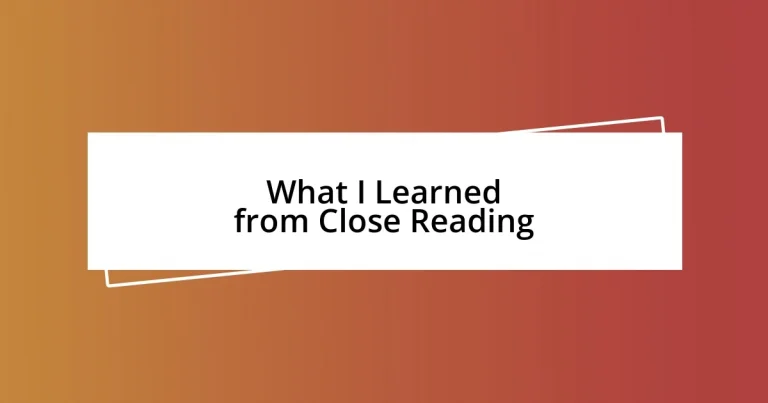Key takeaways:
- Close reading enhances comprehension, critical thinking, and emotional connection to literature, allowing readers to discover deeper meanings and appreciate authors’ craft.
- Effective close reading techniques include annotating texts, reading aloud for auditory insights, and focusing on literary elements like metaphor and symbolism.
- Applying insights from close reading improves personal writing skills by enhancing word choice, layering narratives, and understanding structural impact, resulting in more engaging and thoughtful prose.
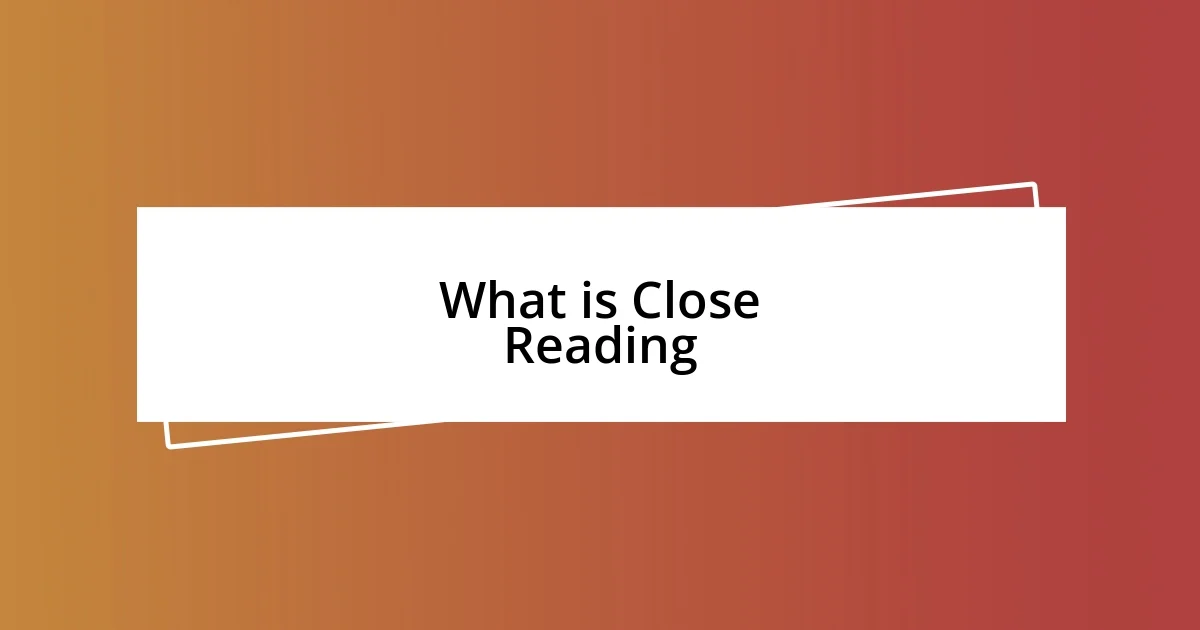
What is Close Reading
Close reading is a meticulous approach to analyzing a text that invites readers to engage deeply with the words on the page. I remember a time when I stumbled upon a poem that seemed simple at first glance. However, upon closer inspection, I discovered layers of meaning hidden within the imagery and structure, almost like peeling back the skin of an onion to reveal its core.
As I delved into the nuances of the text, I learned that close reading goes beyond just understanding the surface meaning. It’s about immersing yourself in the language, examining the choice of words, and considering how they contribute to the overall message. Have you ever caught yourself reading a paragraph multiple times because something in it resonated with you? That’s the essence of close reading; it allows you to connect with a text on a profound level.
In my experience, close reading fosters a richer appreciation for literature, encouraging curiosity and critical thinking. I often find myself questioning the author’s intent or the emotions behind a character’s actions. This practice isn’t just academic; it becomes a personal exploration that transforms the way I perceive stories and the world around me.
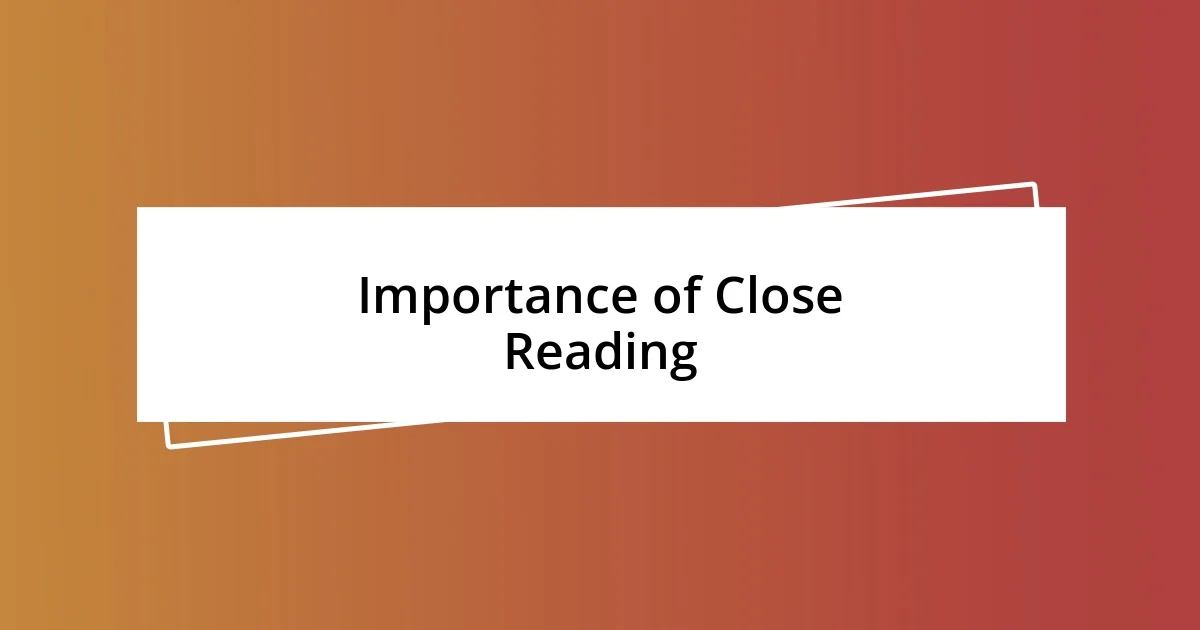
Importance of Close Reading
The importance of close reading cannot be overstated. It sharpens our analytical skills and cultivates a deeper appreciation for the intricacies of language. I recall dissecting a classic novel, and the more I honed in on the text, the clearer the subtleties of character development became. It was a revelation; every word choice seemed intentional, revealing the author’s craft and intent—something I often overlooked in casual reading.
Consider these key benefits of close reading:
- Enhanced Comprehension: You gain a more profound understanding of the text’s themes and ideas.
- Critical Thinking Skills: Engaging with the text critically encourages questioning and analysis.
- Emotional Connection: You foster a personal bond with characters and narratives, making the reading experience more immersive.
- Appreciation of Craft: By examining language choices, you develop a keen eye for the artistry in writing.
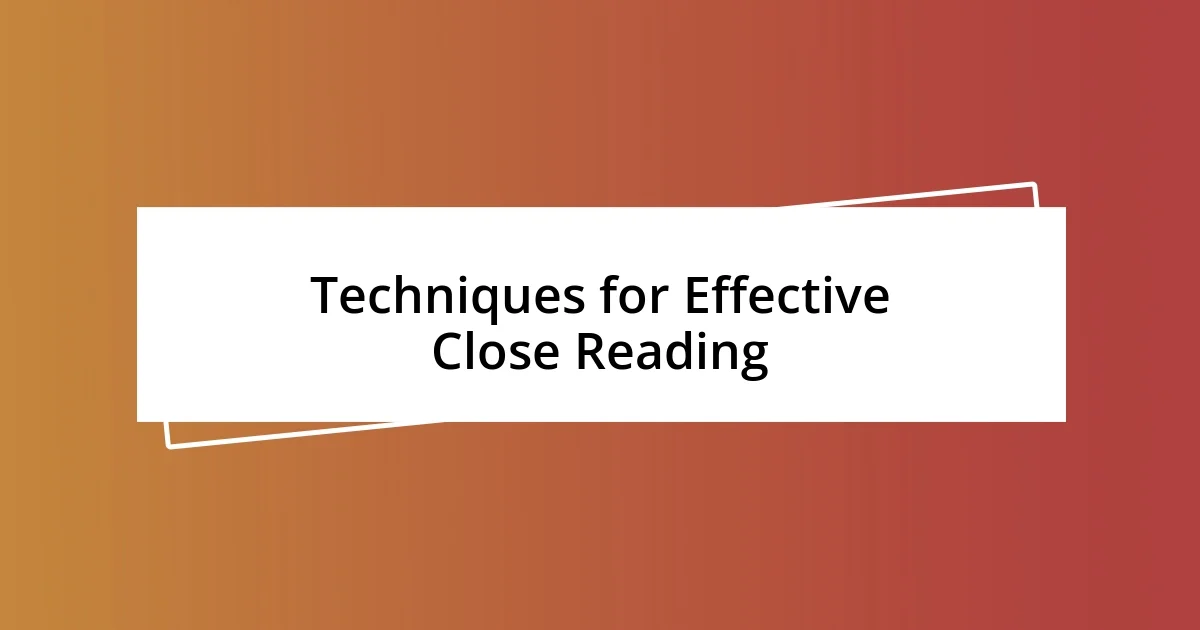
Techniques for Effective Close Reading
To effectively engage in close reading, there are several techniques I’ve found invaluable. First, annotating the text can greatly enhance understanding. I often jot down my thoughts, questions, and reflections in the margins. This practice not only keeps me actively involved with the material but also creates a dialogue with the text that clarifies my thinking. Imagine flipping back to a poem and seeing your initial reactions; it’s like revisiting an old friend with whom you’ve shared an intimate conversation.
Another technique I utilize is reading aloud. It may seem simple, but vocalizing the text changes how I perceive it. The rhythm of the language resonates differently when heard, and subtle meanings often emerge that I might miss during silent reading. I recall struggling with a passage in a novel, but once I read it out loud, the emotions conveyed became crystal clear. Have you ever experienced a passage transforming in meaning simply by listening to it? This technique is a game-changer!
Lastly, focusing on specific elements—like the use of metaphors or symbolism—can deepen my analysis. I’ve found that isolating these components helps unravel the fabric of a piece. For example, in a short story that fascinated me, honing in on the recurring motif of light and darkness illuminated the protagonist’s inner conflict. It made me feel connected to the character’s journey, as if I were part of their world.
| Technique | Description |
|---|---|
| Annotating | Jotting down thoughts and reflections in the margins to create a dialogue with the text. |
| Reading Aloud | Vocalizing the text to uncover deeper meanings through a different auditory experience. |
| Focusing on Elements | Isolating specific literary devices like metaphors to enhance understanding and emotional connection. |

Analyzing Textual Details
When delving into the details of a text, I find that paying attention to small elements can unlock layers of meaning I didn’t initially notice. For instance, during a close reading of a contemporary novel, I stumbled upon a seemingly insignificant description of a character’s worn-out shoes. It hit me then that the shoes symbolized the character’s struggles, reflecting their journey and hardships. Have you ever thought about how a single detail can redefine your understanding of a character?
I also emphasize the power of word choice and syntax. By closely analyzing the author’s language, I often discover nuances that reveal deeper themes. There was a time when I examined a poem where the choice of the word “whisper” over “shout” completely shifted the tone and implied intimacy, evoking a wistful memory. How do you think a single word can resonate differently with each reader’s experience?
Moreover, analyzing dialogue is a treasure trove of information. I remember reading a play and realizing that the pauses and silences were just as telling as the spoken lines. The characters’ unspoken words and body language created an underlying tension that added depth to the narrative. Doesn’t it amaze you how much context lies in what’s not said? Exploring these textual details transforms my reading from a passive duty into an enriching dialogue.
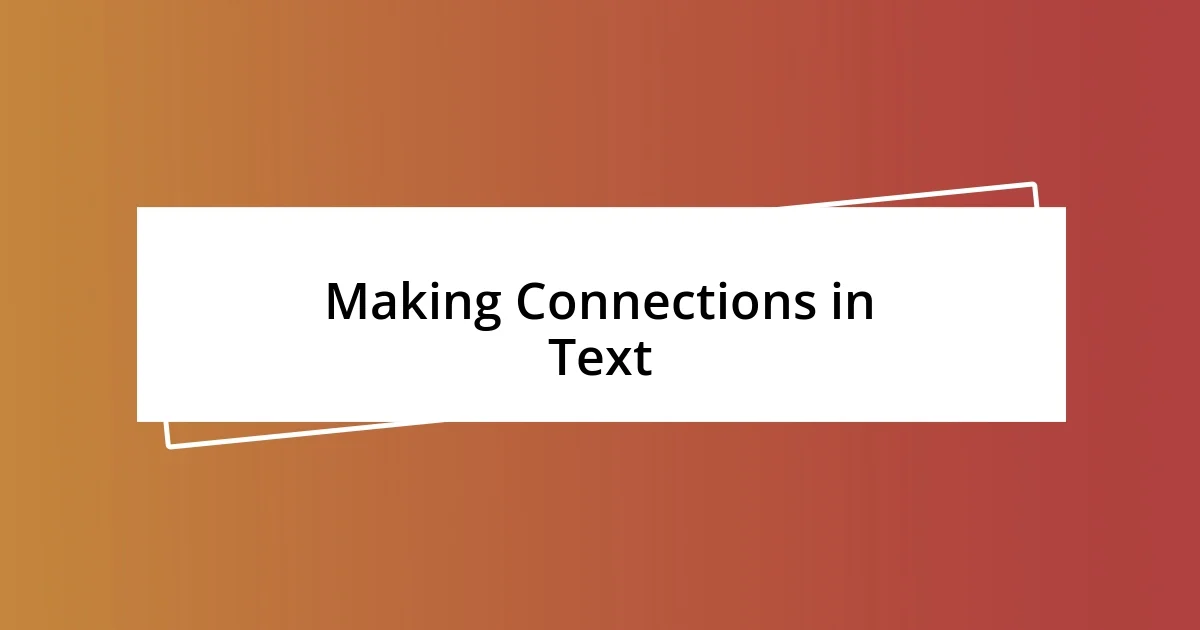
Making Connections in Text
Making connections in a text is one of the most rewarding aspects of close reading. I find that linking characters’ experiences to my own life often leads to a richer understanding of their journeys. For example, when I read a story about a character grappling with loss, I couldn’t help but reflect on my own experiences. This connection led me to a deeper empathy for the character, allowing me to engage with their pain in a way that felt personal and transformative. Isn’t it fascinating how fiction can mirror our realities?
I also appreciate the connections between different texts and themes. Consider two novels exploring the idea of resilience; I once found myself drawing parallels between the characters’ struggles and the broader societal issues they faced. This interplay enriched my reading, allowing me to see threads of resilience across various narratives. Isn’t it incredible how literature can create a tapestry of understanding, revealing shared human experiences?
Another layer I often explore is the historical context within which a text was written. While reading a novel set during a significant historical event, I realized how the characters’ actions resonated with real-life struggles from that era. This perspective not only illuminated the text but also enhanced my appreciation for the author’s craft in weaving together fiction and history. Have you ever felt transported to another time through a character’s struggles? Making these connections can deepen our insights and foster a profound respect for literature.
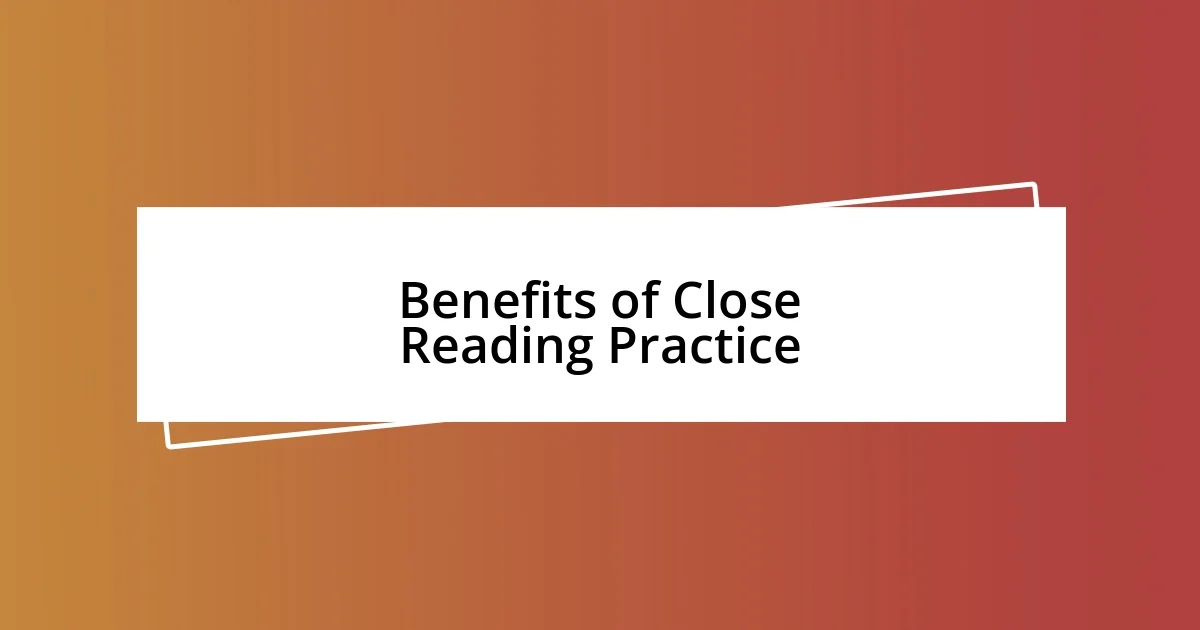
Benefits of Close Reading Practice
Close reading has significantly sharpened my analytical skills, allowing me to appreciate the complexities of texts in ways that I hadn’t anticipated. I recall a time when I delved into a short story that initially seemed straightforward. However, as I dissected the structure and pacing, I found it revealed a profound commentary on time and memory. Have you ever been surprised by how much a piece can shift when you pay closer attention?
One of the most rewarding benefits I’ve experienced is the newfound confidence that comes with my ability to interpret texts. After diving deeply into a classic novel, I could articulate my thoughts in discussions with friends who hadn’t engaged as deeply. The look of admiration when I shared my insights reminded me that we often underestimate the power of careful reading. Have you ever felt that sense of achievement when you connect the dots that others might miss?
Moreover, close reading cultivates a genuine appreciation for an author’s craft. I remember reading a collection of essays where the intricate use of metaphor painted vivid imagery. Reflecting on those passages, I felt a sense of awe for the artistry involved. How does it feel to admire someone’s work not just for what it says, but for how it’s constructed? This practice enriches my understanding of literature while deepening my respect for the creativity of writers.
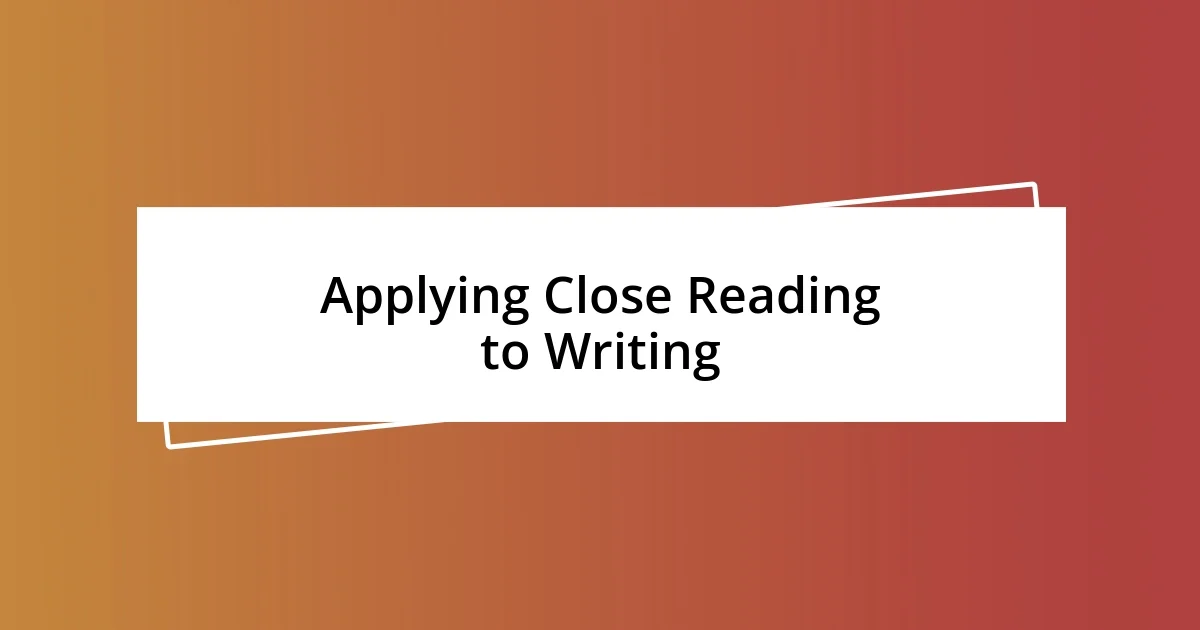
Applying Close Reading to Writing
Applying close reading techniques to my own writing has transformed how I approach crafting sentences. For instance, when I focus on word choice during my drafting process, I’m often reminded of how authors select specific words to evoke emotions. Last week, I rewrote a paragraph multiple times, experimenting with synonyms until I found the perfect term that sparkled with the intended feeling. Have you ever found a single word that completely changed the mood of your writing?
Creating layers in my narratives has also become a skill sharpened by close reading. When studying a well-crafted novel, I noticed how an author wove subtext into dialogue. Inspired by this, I decided to apply subtle hints in my own characters’ conversations, allowing readers to infer emotions and motives. This practice not only enriched my storytelling but also invited readers into a more intimate relationship with the text. Isn’t it rewarding when readers can uncover secrets hidden within your words?
Finally, I’ve learned to appreciate the power of structure, much like a music composer understands rhythm and melody. After analyzing a particularly impactful piece, I experimented with paragraph breaks in my writing, creating pauses that elicited thoughtful reflection. I recall feeling a surge of excitement when my editor pointed out how these breaks heightened emotional moments in my manuscript. Have you ever realized that the way something is presented can be just as powerful as the content itself? It’s these insights from close reading that have led me to embrace a more thoughtful, deliberate approach to my writing.












